Hospitality Marketing: Strategies, Mix, Consumer Analysis, and Trends
VerifiedAdded on 2020/11/23
|14
|3717
|483
Report
AI Summary
This report provides a comprehensive overview of marketing within the hospitality industry. It begins by defining core marketing concepts and then explores the impact of the marketing environment, including both micro and macro factors such as suppliers, customers, competitors, political, economic, sociological, and technological influences. The report emphasizes the relevance of consumer markets, highlighting the importance of understanding consumer behavior and market segmentation. It examines various segmentation methods, including geographic, demographic, behavioral, and psychographic approaches. Furthermore, the report analyzes the components of the marketing mix (product, price, place, and promotion) with a case study on Thomas Cook, including their pricing strategies and promotional activities. It also discusses pricing strategies and policies within the broader hospitality sector, and the role of the promotional mix. The report also touches on market research, advertising campaigns, and the use of different media for marketing hospitality products and services, concluding with the implementation of a marketing plan.
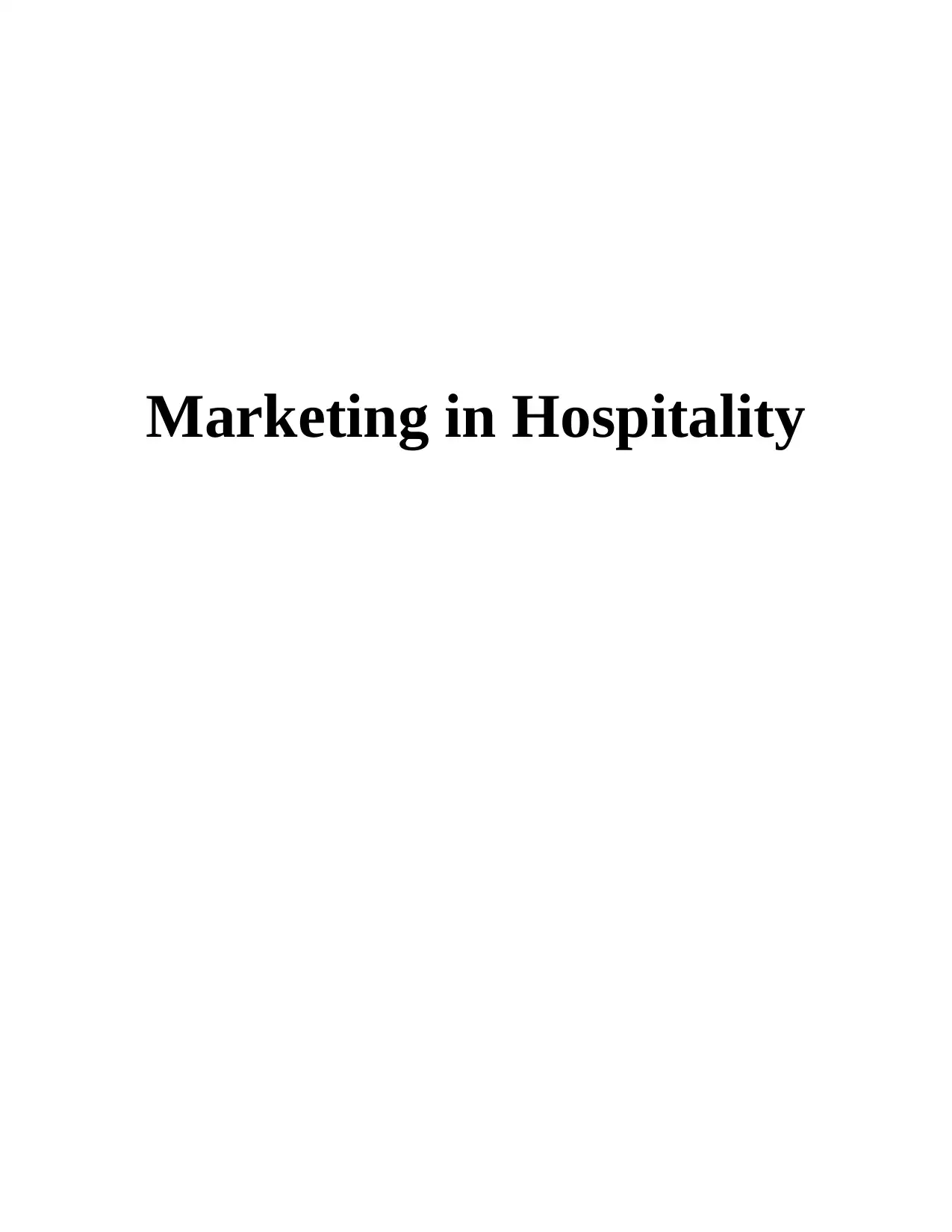
Marketing in Hospitality
Paraphrase This Document
Need a fresh take? Get an instant paraphrase of this document with our AI Paraphraser
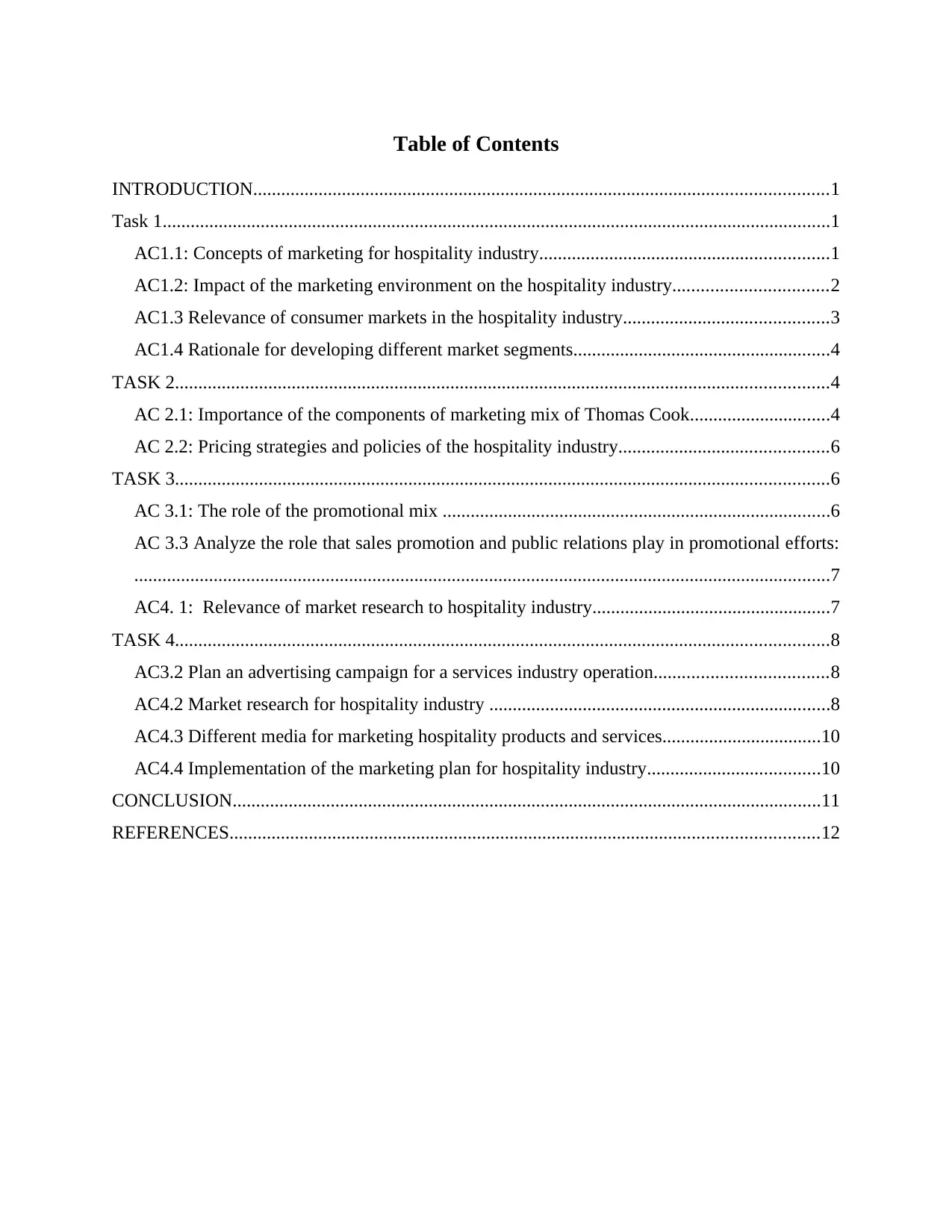
Table of Contents
INTRODUCTION...........................................................................................................................1
Task 1...............................................................................................................................................1
AC1.1: Concepts of marketing for hospitality industry..............................................................1
AC1.2: Impact of the marketing environment on the hospitality industry.................................2
AC1.3 Relevance of consumer markets in the hospitality industry............................................3
AC1.4 Rationale for developing different market segments.......................................................4
TASK 2............................................................................................................................................4
AC 2.1: Importance of the components of marketing mix of Thomas Cook..............................4
AC 2.2: Pricing strategies and policies of the hospitality industry.............................................6
TASK 3............................................................................................................................................6
AC 3.1: The role of the promotional mix ...................................................................................6
AC 3.3 Analyze the role that sales promotion and public relations play in promotional efforts:
.....................................................................................................................................................7
AC4. 1: Relevance of market research to hospitality industry...................................................7
TASK 4............................................................................................................................................8
AC3.2 Plan an advertising campaign for a services industry operation.....................................8
AC4.2 Market research for hospitality industry .........................................................................8
AC4.3 Different media for marketing hospitality products and services..................................10
AC4.4 Implementation of the marketing plan for hospitality industry.....................................10
CONCLUSION..............................................................................................................................11
REFERENCES..............................................................................................................................12
INTRODUCTION...........................................................................................................................1
Task 1...............................................................................................................................................1
AC1.1: Concepts of marketing for hospitality industry..............................................................1
AC1.2: Impact of the marketing environment on the hospitality industry.................................2
AC1.3 Relevance of consumer markets in the hospitality industry............................................3
AC1.4 Rationale for developing different market segments.......................................................4
TASK 2............................................................................................................................................4
AC 2.1: Importance of the components of marketing mix of Thomas Cook..............................4
AC 2.2: Pricing strategies and policies of the hospitality industry.............................................6
TASK 3............................................................................................................................................6
AC 3.1: The role of the promotional mix ...................................................................................6
AC 3.3 Analyze the role that sales promotion and public relations play in promotional efforts:
.....................................................................................................................................................7
AC4. 1: Relevance of market research to hospitality industry...................................................7
TASK 4............................................................................................................................................8
AC3.2 Plan an advertising campaign for a services industry operation.....................................8
AC4.2 Market research for hospitality industry .........................................................................8
AC4.3 Different media for marketing hospitality products and services..................................10
AC4.4 Implementation of the marketing plan for hospitality industry.....................................10
CONCLUSION..............................................................................................................................11
REFERENCES..............................................................................................................................12

INTRODUCTION
Hospitality marketing is process of segmenting the industry such as hotels, restaurants,
resorts and amusement parks and utilizing marketing techniques for promoting their products and
services. It is the effort for achieving increased revenue and market share along with boosting the
profitability. Customer loyalty is the key, marketing managers and executives dedicate time and
resources for building awareness of brand by putting in efforts to target old guests and attract
new clients ( Walker, 2016). This assignment discusses the concepts of marketing, impact of
marketing environment on hospitality industry, segments of market, marketing mix etc. It also
studies about the behaviour of consumer, technological tools for marketing activity and trends in
the sector. Main motive of this assignment is to understand the importance of promotional
activities for marketing hospitality and role played by marketing cycle in a service industry.
Task 1
AC1.1: Concepts of marketing for hospitality industry.
The Organizational process of understanding the customer's needs and demands and satisfying
them by providing quality products and services is called marketing. It is a continuous activity of
analyzing the market and forming strategies to achieve marketing objectives set by the company. This
is a set of rules aimed at building customer relationships, communicating and delivering value to the
clients at the same time benefiting the organization and its stakeholders. For the efficient use of
marketing tools to attain profitability in business integration of customers is necessary. Integrated
marketing where efforts of all individuals in a firm are combined after analyzing the customer needs
will enhance in revenue generation.
The product concept- Producing quality products or services and setting reasonable price for the
output will make the marketing effort less. According to this the customers prefers goods and services
which are easily available and cheap in the market. It concentrates on low production costs with
increased efficiency and large production volume.
The selling concept- It assumes that consumers are looking for competitive sales and promotional
activities from companies (Kandampully and et.al 2010). Therefore firms should use large scale
promotional and selling efforts. This is usually applied on products which consumers generally don't
consume.
The marketing concept- This analyzes the needs of a firm's customers and make decisions for
satisfying their wants and demand better than the competition. It fully depends on client's requirement
1
Hospitality marketing is process of segmenting the industry such as hotels, restaurants,
resorts and amusement parks and utilizing marketing techniques for promoting their products and
services. It is the effort for achieving increased revenue and market share along with boosting the
profitability. Customer loyalty is the key, marketing managers and executives dedicate time and
resources for building awareness of brand by putting in efforts to target old guests and attract
new clients ( Walker, 2016). This assignment discusses the concepts of marketing, impact of
marketing environment on hospitality industry, segments of market, marketing mix etc. It also
studies about the behaviour of consumer, technological tools for marketing activity and trends in
the sector. Main motive of this assignment is to understand the importance of promotional
activities for marketing hospitality and role played by marketing cycle in a service industry.
Task 1
AC1.1: Concepts of marketing for hospitality industry.
The Organizational process of understanding the customer's needs and demands and satisfying
them by providing quality products and services is called marketing. It is a continuous activity of
analyzing the market and forming strategies to achieve marketing objectives set by the company. This
is a set of rules aimed at building customer relationships, communicating and delivering value to the
clients at the same time benefiting the organization and its stakeholders. For the efficient use of
marketing tools to attain profitability in business integration of customers is necessary. Integrated
marketing where efforts of all individuals in a firm are combined after analyzing the customer needs
will enhance in revenue generation.
The product concept- Producing quality products or services and setting reasonable price for the
output will make the marketing effort less. According to this the customers prefers goods and services
which are easily available and cheap in the market. It concentrates on low production costs with
increased efficiency and large production volume.
The selling concept- It assumes that consumers are looking for competitive sales and promotional
activities from companies (Kandampully and et.al 2010). Therefore firms should use large scale
promotional and selling efforts. This is usually applied on products which consumers generally don't
consume.
The marketing concept- This analyzes the needs of a firm's customers and make decisions for
satisfying their wants and demand better than the competition. It fully depends on client's requirement
1
⊘ This is a preview!⊘
Do you want full access?
Subscribe today to unlock all pages.

Trusted by 1+ million students worldwide
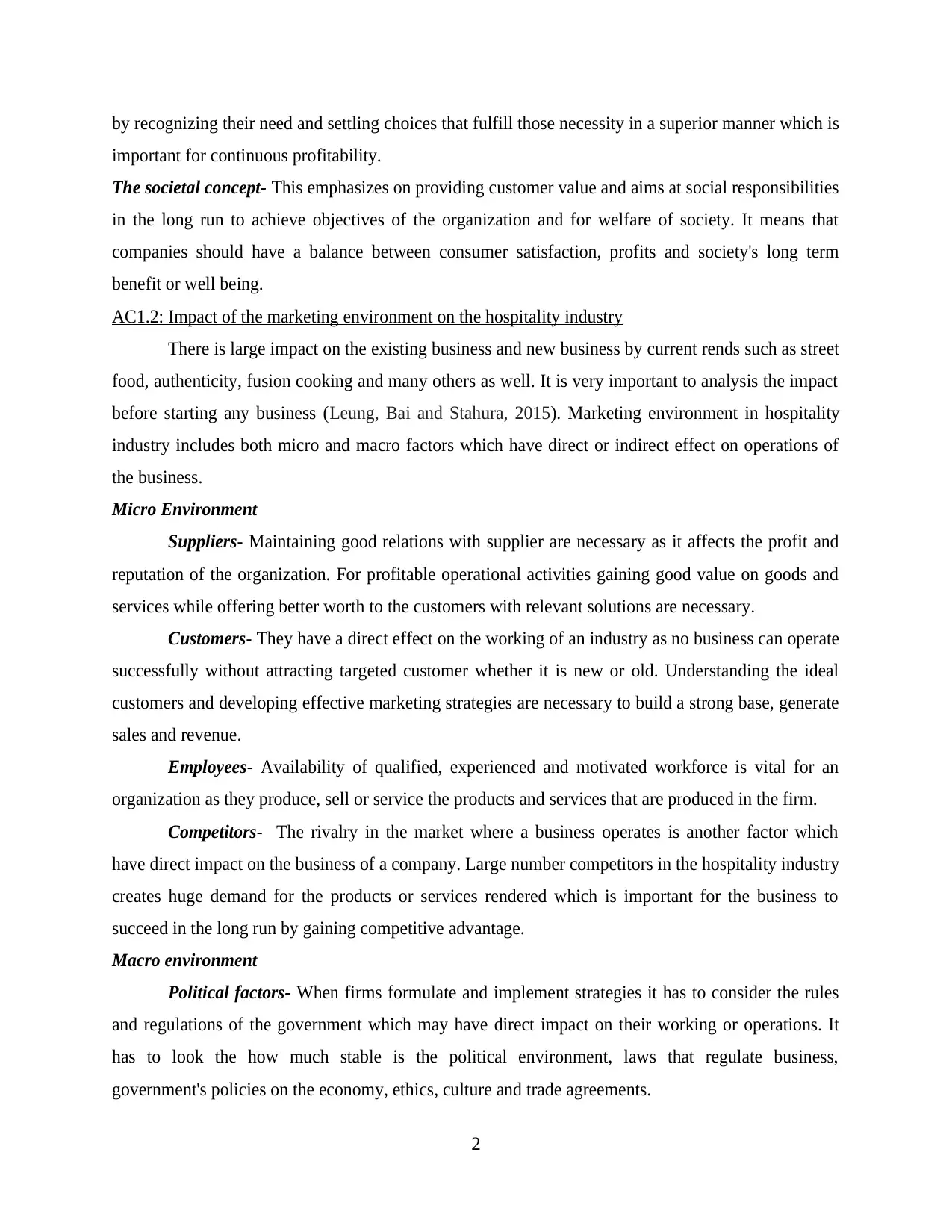
by recognizing their need and settling choices that fulfill those necessity in a superior manner which is
important for continuous profitability.
The societal concept- This emphasizes on providing customer value and aims at social responsibilities
in the long run to achieve objectives of the organization and for welfare of society. It means that
companies should have a balance between consumer satisfaction, profits and society's long term
benefit or well being.
AC1.2: Impact of the marketing environment on the hospitality industry
There is large impact on the existing business and new business by current rends such as street
food, authenticity, fusion cooking and many others as well. It is very important to analysis the impact
before starting any business (Leung, Bai and Stahura, 2015). Marketing environment in hospitality
industry includes both micro and macro factors which have direct or indirect effect on operations of
the business.
Micro Environment
Suppliers- Maintaining good relations with supplier are necessary as it affects the profit and
reputation of the organization. For profitable operational activities gaining good value on goods and
services while offering better worth to the customers with relevant solutions are necessary.
Customers- They have a direct effect on the working of an industry as no business can operate
successfully without attracting targeted customer whether it is new or old. Understanding the ideal
customers and developing effective marketing strategies are necessary to build a strong base, generate
sales and revenue.
Employees- Availability of qualified, experienced and motivated workforce is vital for an
organization as they produce, sell or service the products and services that are produced in the firm.
Competitors- The rivalry in the market where a business operates is another factor which
have direct impact on the business of a company. Large number competitors in the hospitality industry
creates huge demand for the products or services rendered which is important for the business to
succeed in the long run by gaining competitive advantage.
Macro environment
Political factors- When firms formulate and implement strategies it has to consider the rules
and regulations of the government which may have direct impact on their working or operations. It
has to look the how much stable is the political environment, laws that regulate business,
government's policies on the economy, ethics, culture and trade agreements.
2
important for continuous profitability.
The societal concept- This emphasizes on providing customer value and aims at social responsibilities
in the long run to achieve objectives of the organization and for welfare of society. It means that
companies should have a balance between consumer satisfaction, profits and society's long term
benefit or well being.
AC1.2: Impact of the marketing environment on the hospitality industry
There is large impact on the existing business and new business by current rends such as street
food, authenticity, fusion cooking and many others as well. It is very important to analysis the impact
before starting any business (Leung, Bai and Stahura, 2015). Marketing environment in hospitality
industry includes both micro and macro factors which have direct or indirect effect on operations of
the business.
Micro Environment
Suppliers- Maintaining good relations with supplier are necessary as it affects the profit and
reputation of the organization. For profitable operational activities gaining good value on goods and
services while offering better worth to the customers with relevant solutions are necessary.
Customers- They have a direct effect on the working of an industry as no business can operate
successfully without attracting targeted customer whether it is new or old. Understanding the ideal
customers and developing effective marketing strategies are necessary to build a strong base, generate
sales and revenue.
Employees- Availability of qualified, experienced and motivated workforce is vital for an
organization as they produce, sell or service the products and services that are produced in the firm.
Competitors- The rivalry in the market where a business operates is another factor which
have direct impact on the business of a company. Large number competitors in the hospitality industry
creates huge demand for the products or services rendered which is important for the business to
succeed in the long run by gaining competitive advantage.
Macro environment
Political factors- When firms formulate and implement strategies it has to consider the rules
and regulations of the government which may have direct impact on their working or operations. It
has to look the how much stable is the political environment, laws that regulate business,
government's policies on the economy, ethics, culture and trade agreements.
2
Paraphrase This Document
Need a fresh take? Get an instant paraphrase of this document with our AI Paraphraser
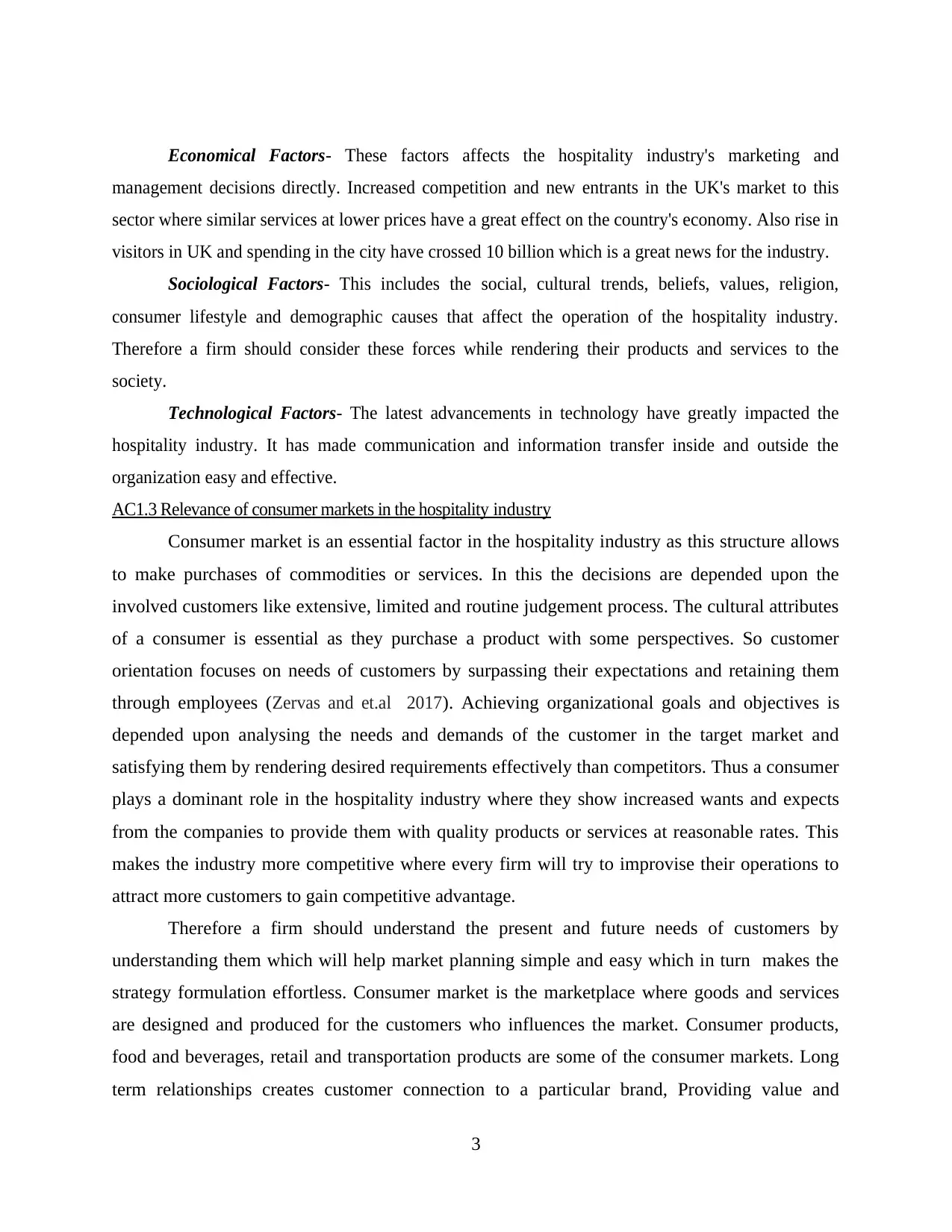
Economical Factors- These factors affects the hospitality industry's marketing and
management decisions directly. Increased competition and new entrants in the UK's market to this
sector where similar services at lower prices have a great effect on the country's economy. Also rise in
visitors in UK and spending in the city have crossed 10 billion which is a great news for the industry.
Sociological Factors- This includes the social, cultural trends, beliefs, values, religion,
consumer lifestyle and demographic causes that affect the operation of the hospitality industry.
Therefore a firm should consider these forces while rendering their products and services to the
society.
Technological Factors- The latest advancements in technology have greatly impacted the
hospitality industry. It has made communication and information transfer inside and outside the
organization easy and effective.
AC1.3 Relevance of consumer markets in the hospitality industry
Consumer market is an essential factor in the hospitality industry as this structure allows
to make purchases of commodities or services. In this the decisions are depended upon the
involved customers like extensive, limited and routine judgement process. The cultural attributes
of a consumer is essential as they purchase a product with some perspectives. So customer
orientation focuses on needs of customers by surpassing their expectations and retaining them
through employees ( Zervas and et.al 2017). Achieving organizational goals and objectives is
depended upon analysing the needs and demands of the customer in the target market and
satisfying them by rendering desired requirements effectively than competitors. Thus a consumer
plays a dominant role in the hospitality industry where they show increased wants and expects
from the companies to provide them with quality products or services at reasonable rates. This
makes the industry more competitive where every firm will try to improvise their operations to
attract more customers to gain competitive advantage.
Therefore a firm should understand the present and future needs of customers by
understanding them which will help market planning simple and easy which in turn makes the
strategy formulation effortless. Consumer market is the marketplace where goods and services
are designed and produced for the customers who influences the market. Consumer products,
food and beverages, retail and transportation products are some of the consumer markets. Long
term relationships creates customer connection to a particular brand, Providing value and
3
management decisions directly. Increased competition and new entrants in the UK's market to this
sector where similar services at lower prices have a great effect on the country's economy. Also rise in
visitors in UK and spending in the city have crossed 10 billion which is a great news for the industry.
Sociological Factors- This includes the social, cultural trends, beliefs, values, religion,
consumer lifestyle and demographic causes that affect the operation of the hospitality industry.
Therefore a firm should consider these forces while rendering their products and services to the
society.
Technological Factors- The latest advancements in technology have greatly impacted the
hospitality industry. It has made communication and information transfer inside and outside the
organization easy and effective.
AC1.3 Relevance of consumer markets in the hospitality industry
Consumer market is an essential factor in the hospitality industry as this structure allows
to make purchases of commodities or services. In this the decisions are depended upon the
involved customers like extensive, limited and routine judgement process. The cultural attributes
of a consumer is essential as they purchase a product with some perspectives. So customer
orientation focuses on needs of customers by surpassing their expectations and retaining them
through employees ( Zervas and et.al 2017). Achieving organizational goals and objectives is
depended upon analysing the needs and demands of the customer in the target market and
satisfying them by rendering desired requirements effectively than competitors. Thus a consumer
plays a dominant role in the hospitality industry where they show increased wants and expects
from the companies to provide them with quality products or services at reasonable rates. This
makes the industry more competitive where every firm will try to improvise their operations to
attract more customers to gain competitive advantage.
Therefore a firm should understand the present and future needs of customers by
understanding them which will help market planning simple and easy which in turn makes the
strategy formulation effortless. Consumer market is the marketplace where goods and services
are designed and produced for the customers who influences the market. Consumer products,
food and beverages, retail and transportation products are some of the consumer markets. Long
term relationships creates customer connection to a particular brand, Providing value and
3
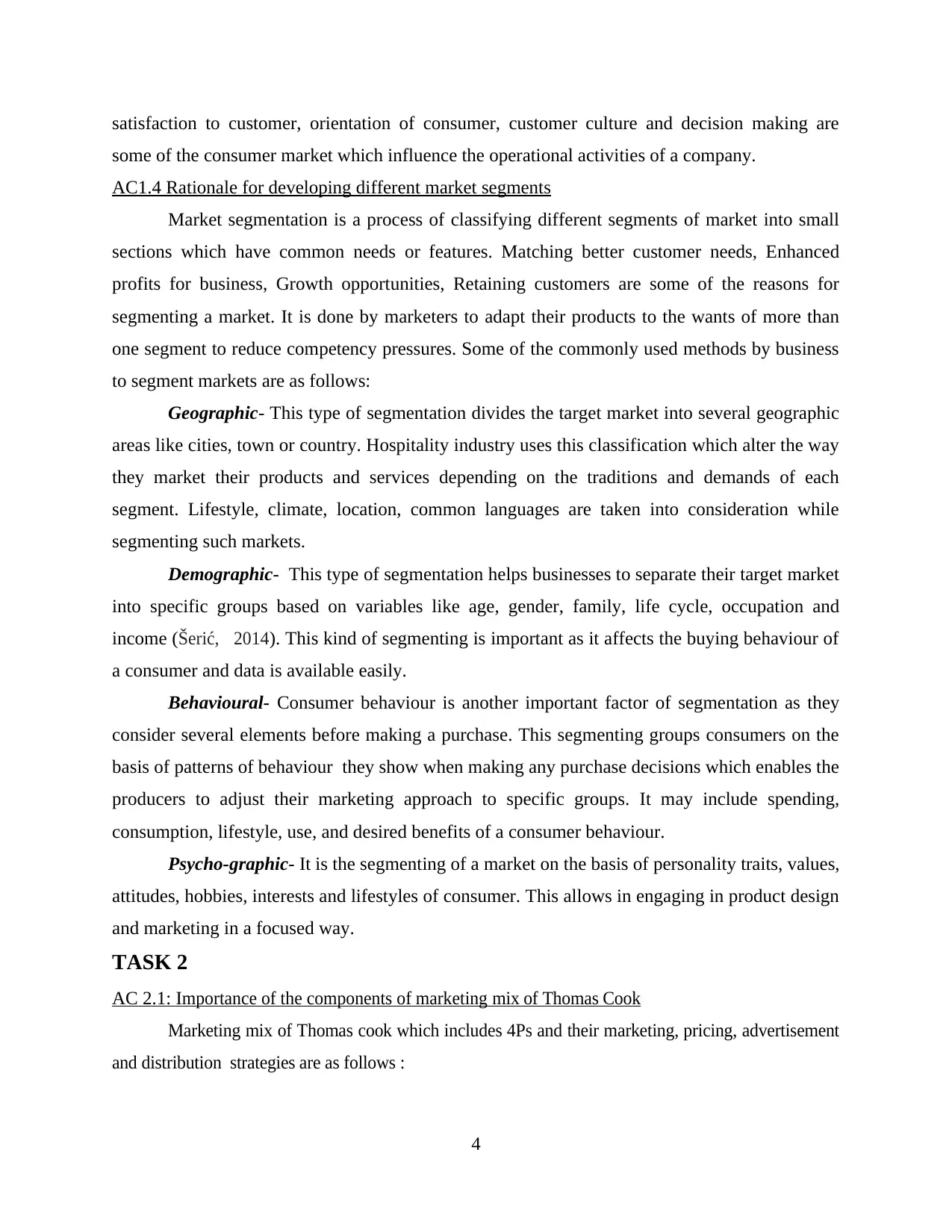
satisfaction to customer, orientation of consumer, customer culture and decision making are
some of the consumer market which influence the operational activities of a company.
AC1.4 Rationale for developing different market segments
Market segmentation is a process of classifying different segments of market into small
sections which have common needs or features. Matching better customer needs, Enhanced
profits for business, Growth opportunities, Retaining customers are some of the reasons for
segmenting a market. It is done by marketers to adapt their products to the wants of more than
one segment to reduce competency pressures. Some of the commonly used methods by business
to segment markets are as follows:
Geographic- This type of segmentation divides the target market into several geographic
areas like cities, town or country. Hospitality industry uses this classification which alter the way
they market their products and services depending on the traditions and demands of each
segment. Lifestyle, climate, location, common languages are taken into consideration while
segmenting such markets.
Demographic- This type of segmentation helps businesses to separate their target market
into specific groups based on variables like age, gender, family, life cycle, occupation and
income ( Šerić, 2014). This kind of segmenting is important as it affects the buying behaviour of
a consumer and data is available easily.
Behavioural- Consumer behaviour is another important factor of segmentation as they
consider several elements before making a purchase. This segmenting groups consumers on the
basis of patterns of behaviour they show when making any purchase decisions which enables the
producers to adjust their marketing approach to specific groups. It may include spending,
consumption, lifestyle, use, and desired benefits of a consumer behaviour.
Psycho-graphic- It is the segmenting of a market on the basis of personality traits, values,
attitudes, hobbies, interests and lifestyles of consumer. This allows in engaging in product design
and marketing in a focused way.
TASK 2
AC 2.1: Importance of the components of marketing mix of Thomas Cook
Marketing mix of Thomas cook which includes 4Ps and their marketing, pricing, advertisement
and distribution strategies are as follows :
4
some of the consumer market which influence the operational activities of a company.
AC1.4 Rationale for developing different market segments
Market segmentation is a process of classifying different segments of market into small
sections which have common needs or features. Matching better customer needs, Enhanced
profits for business, Growth opportunities, Retaining customers are some of the reasons for
segmenting a market. It is done by marketers to adapt their products to the wants of more than
one segment to reduce competency pressures. Some of the commonly used methods by business
to segment markets are as follows:
Geographic- This type of segmentation divides the target market into several geographic
areas like cities, town or country. Hospitality industry uses this classification which alter the way
they market their products and services depending on the traditions and demands of each
segment. Lifestyle, climate, location, common languages are taken into consideration while
segmenting such markets.
Demographic- This type of segmentation helps businesses to separate their target market
into specific groups based on variables like age, gender, family, life cycle, occupation and
income ( Šerić, 2014). This kind of segmenting is important as it affects the buying behaviour of
a consumer and data is available easily.
Behavioural- Consumer behaviour is another important factor of segmentation as they
consider several elements before making a purchase. This segmenting groups consumers on the
basis of patterns of behaviour they show when making any purchase decisions which enables the
producers to adjust their marketing approach to specific groups. It may include spending,
consumption, lifestyle, use, and desired benefits of a consumer behaviour.
Psycho-graphic- It is the segmenting of a market on the basis of personality traits, values,
attitudes, hobbies, interests and lifestyles of consumer. This allows in engaging in product design
and marketing in a focused way.
TASK 2
AC 2.1: Importance of the components of marketing mix of Thomas Cook
Marketing mix of Thomas cook which includes 4Ps and their marketing, pricing, advertisement
and distribution strategies are as follows :
4
⊘ This is a preview!⊘
Do you want full access?
Subscribe today to unlock all pages.

Trusted by 1+ million students worldwide
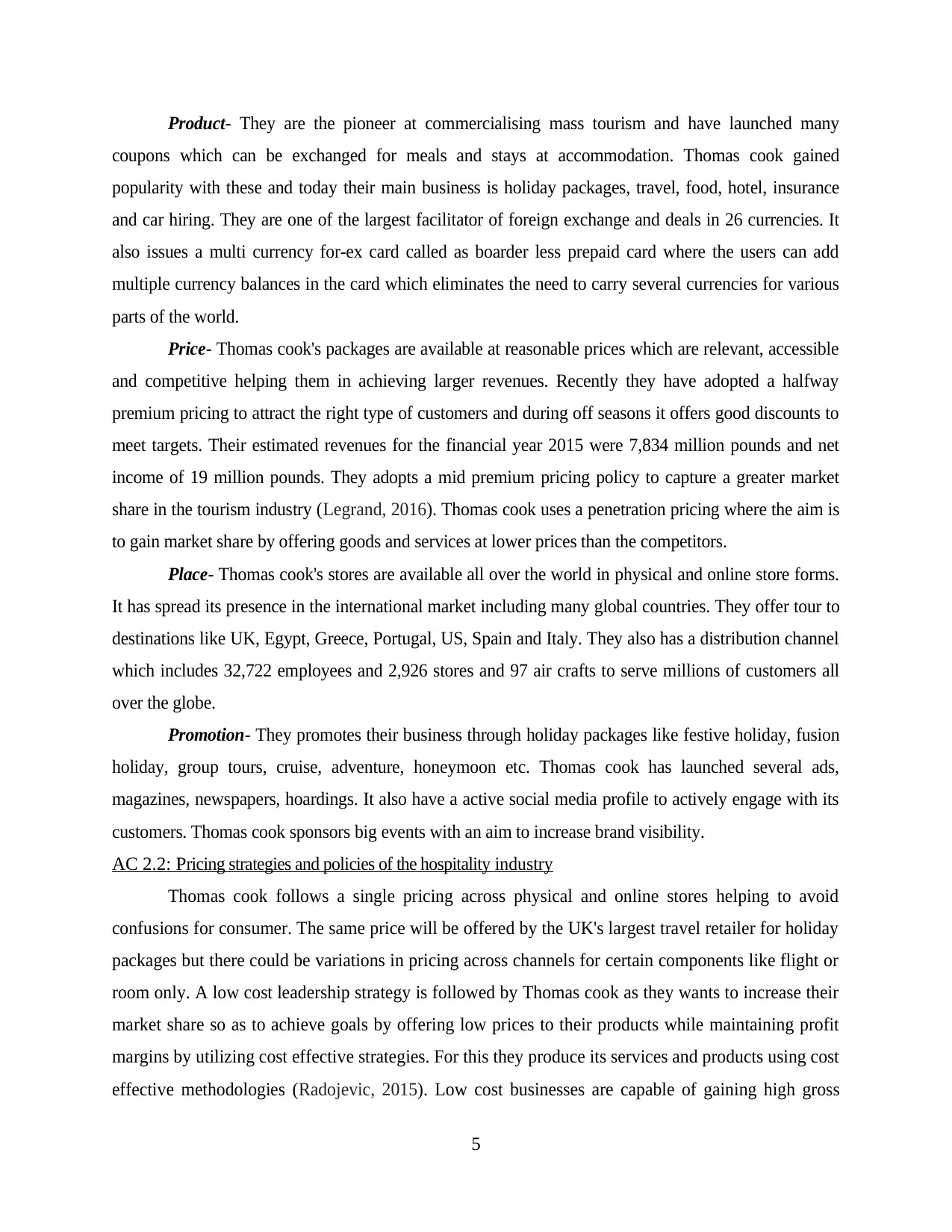
Product- They are the pioneer at commercialising mass tourism and have launched many
coupons which can be exchanged for meals and stays at accommodation. Thomas cook gained
popularity with these and today their main business is holiday packages, travel, food, hotel, insurance
and car hiring. They are one of the largest facilitator of foreign exchange and deals in 26 currencies. It
also issues a multi currency for-ex card called as boarder less prepaid card where the users can add
multiple currency balances in the card which eliminates the need to carry several currencies for various
parts of the world.
Price- Thomas cook's packages are available at reasonable prices which are relevant, accessible
and competitive helping them in achieving larger revenues. Recently they have adopted a halfway
premium pricing to attract the right type of customers and during off seasons it offers good discounts to
meet targets. Their estimated revenues for the financial year 2015 were 7,834 million pounds and net
income of 19 million pounds. They adopts a mid premium pricing policy to capture a greater market
share in the tourism industry (Legrand, 2016). Thomas cook uses a penetration pricing where the aim is
to gain market share by offering goods and services at lower prices than the competitors.
Place- Thomas cook's stores are available all over the world in physical and online store forms.
It has spread its presence in the international market including many global countries. They offer tour to
destinations like UK, Egypt, Greece, Portugal, US, Spain and Italy. They also has a distribution channel
which includes 32,722 employees and 2,926 stores and 97 air crafts to serve millions of customers all
over the globe.
Promotion- They promotes their business through holiday packages like festive holiday, fusion
holiday, group tours, cruise, adventure, honeymoon etc. Thomas cook has launched several ads,
magazines, newspapers, hoardings. It also have a active social media profile to actively engage with its
customers. Thomas cook sponsors big events with an aim to increase brand visibility.
AC 2.2: Pricing strategies and policies of the hospitality industry
Thomas cook follows a single pricing across physical and online stores helping to avoid
confusions for consumer. The same price will be offered by the UK's largest travel retailer for holiday
packages but there could be variations in pricing across channels for certain components like flight or
room only. A low cost leadership strategy is followed by Thomas cook as they wants to increase their
market share so as to achieve goals by offering low prices to their products while maintaining profit
margins by utilizing cost effective strategies. For this they produce its services and products using cost
effective methodologies (Radojevic, 2015). Low cost businesses are capable of gaining high gross
5
coupons which can be exchanged for meals and stays at accommodation. Thomas cook gained
popularity with these and today their main business is holiday packages, travel, food, hotel, insurance
and car hiring. They are one of the largest facilitator of foreign exchange and deals in 26 currencies. It
also issues a multi currency for-ex card called as boarder less prepaid card where the users can add
multiple currency balances in the card which eliminates the need to carry several currencies for various
parts of the world.
Price- Thomas cook's packages are available at reasonable prices which are relevant, accessible
and competitive helping them in achieving larger revenues. Recently they have adopted a halfway
premium pricing to attract the right type of customers and during off seasons it offers good discounts to
meet targets. Their estimated revenues for the financial year 2015 were 7,834 million pounds and net
income of 19 million pounds. They adopts a mid premium pricing policy to capture a greater market
share in the tourism industry (Legrand, 2016). Thomas cook uses a penetration pricing where the aim is
to gain market share by offering goods and services at lower prices than the competitors.
Place- Thomas cook's stores are available all over the world in physical and online store forms.
It has spread its presence in the international market including many global countries. They offer tour to
destinations like UK, Egypt, Greece, Portugal, US, Spain and Italy. They also has a distribution channel
which includes 32,722 employees and 2,926 stores and 97 air crafts to serve millions of customers all
over the globe.
Promotion- They promotes their business through holiday packages like festive holiday, fusion
holiday, group tours, cruise, adventure, honeymoon etc. Thomas cook has launched several ads,
magazines, newspapers, hoardings. It also have a active social media profile to actively engage with its
customers. Thomas cook sponsors big events with an aim to increase brand visibility.
AC 2.2: Pricing strategies and policies of the hospitality industry
Thomas cook follows a single pricing across physical and online stores helping to avoid
confusions for consumer. The same price will be offered by the UK's largest travel retailer for holiday
packages but there could be variations in pricing across channels for certain components like flight or
room only. A low cost leadership strategy is followed by Thomas cook as they wants to increase their
market share so as to achieve goals by offering low prices to their products while maintaining profit
margins by utilizing cost effective strategies. For this they produce its services and products using cost
effective methodologies (Radojevic, 2015). Low cost businesses are capable of gaining high gross
5
Paraphrase This Document
Need a fresh take? Get an instant paraphrase of this document with our AI Paraphraser
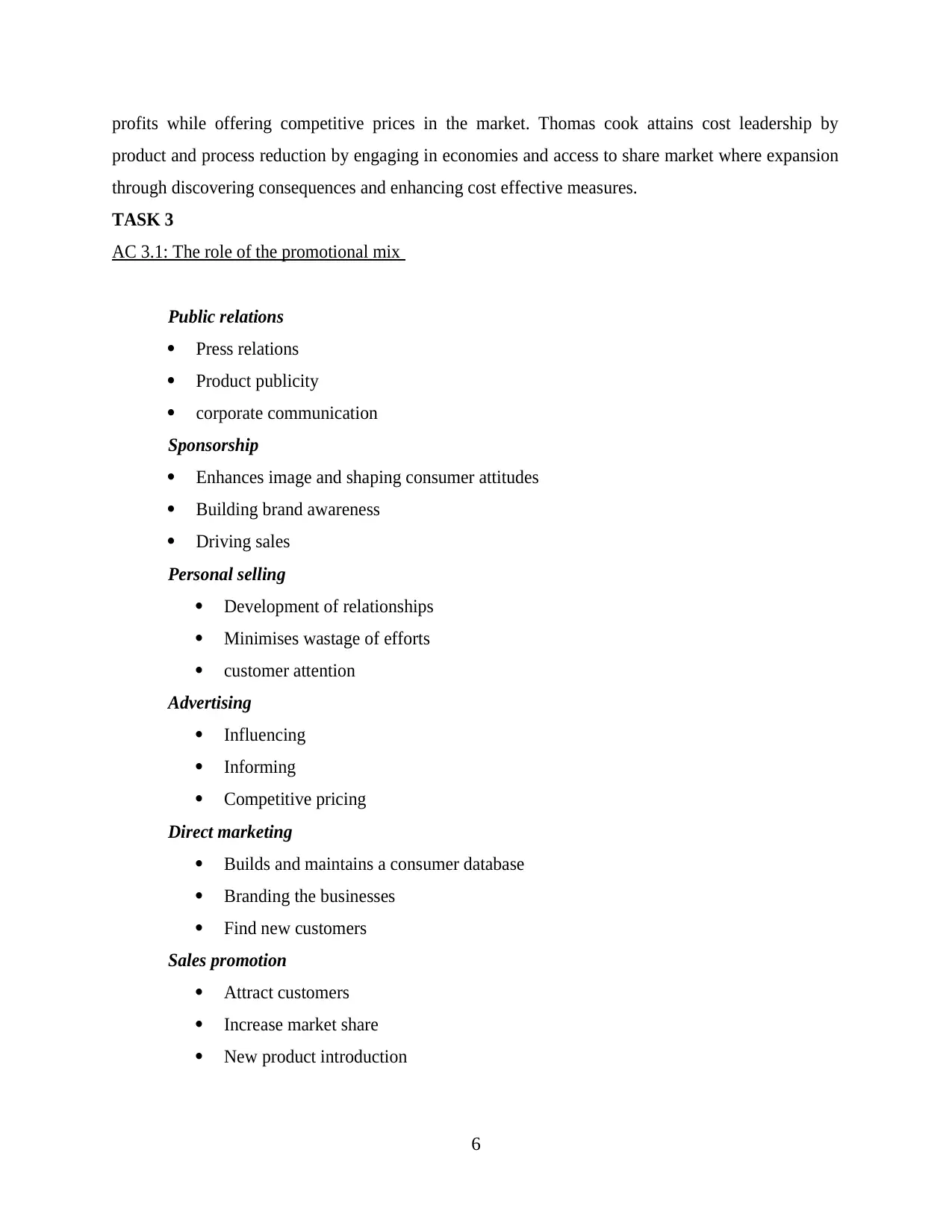
profits while offering competitive prices in the market. Thomas cook attains cost leadership by
product and process reduction by engaging in economies and access to share market where expansion
through discovering consequences and enhancing cost effective measures.
TASK 3
AC 3.1: The role of the promotional mix
Public relations
Press relations
Product publicity
corporate communication
Sponsorship
Enhances image and shaping consumer attitudes
Building brand awareness
Driving sales
Personal selling
Development of relationships
Minimises wastage of efforts
customer attention
Advertising
Influencing
Informing
Competitive pricing
Direct marketing
Builds and maintains a consumer database
Branding the businesses
Find new customers
Sales promotion
Attract customers
Increase market share
New product introduction
6
product and process reduction by engaging in economies and access to share market where expansion
through discovering consequences and enhancing cost effective measures.
TASK 3
AC 3.1: The role of the promotional mix
Public relations
Press relations
Product publicity
corporate communication
Sponsorship
Enhances image and shaping consumer attitudes
Building brand awareness
Driving sales
Personal selling
Development of relationships
Minimises wastage of efforts
customer attention
Advertising
Influencing
Informing
Competitive pricing
Direct marketing
Builds and maintains a consumer database
Branding the businesses
Find new customers
Sales promotion
Attract customers
Increase market share
New product introduction
6
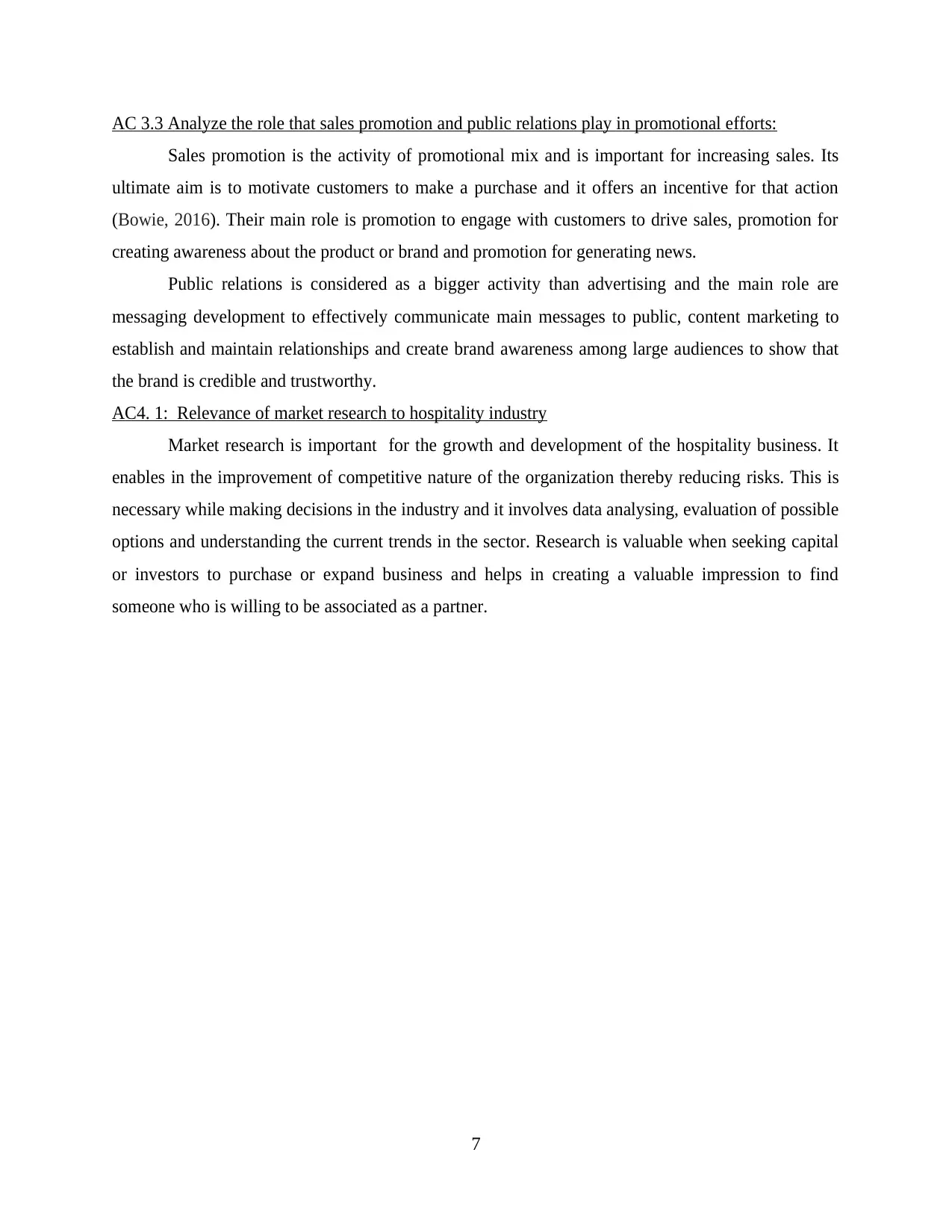
AC 3.3 Analyze the role that sales promotion and public relations play in promotional efforts:
Sales promotion is the activity of promotional mix and is important for increasing sales. Its
ultimate aim is to motivate customers to make a purchase and it offers an incentive for that action
(Bowie, 2016). Their main role is promotion to engage with customers to drive sales, promotion for
creating awareness about the product or brand and promotion for generating news.
Public relations is considered as a bigger activity than advertising and the main role are
messaging development to effectively communicate main messages to public, content marketing to
establish and maintain relationships and create brand awareness among large audiences to show that
the brand is credible and trustworthy.
AC4. 1: Relevance of market research to hospitality industry
Market research is important for the growth and development of the hospitality business. It
enables in the improvement of competitive nature of the organization thereby reducing risks. This is
necessary while making decisions in the industry and it involves data analysing, evaluation of possible
options and understanding the current trends in the sector. Research is valuable when seeking capital
or investors to purchase or expand business and helps in creating a valuable impression to find
someone who is willing to be associated as a partner.
7
Sales promotion is the activity of promotional mix and is important for increasing sales. Its
ultimate aim is to motivate customers to make a purchase and it offers an incentive for that action
(Bowie, 2016). Their main role is promotion to engage with customers to drive sales, promotion for
creating awareness about the product or brand and promotion for generating news.
Public relations is considered as a bigger activity than advertising and the main role are
messaging development to effectively communicate main messages to public, content marketing to
establish and maintain relationships and create brand awareness among large audiences to show that
the brand is credible and trustworthy.
AC4. 1: Relevance of market research to hospitality industry
Market research is important for the growth and development of the hospitality business. It
enables in the improvement of competitive nature of the organization thereby reducing risks. This is
necessary while making decisions in the industry and it involves data analysing, evaluation of possible
options and understanding the current trends in the sector. Research is valuable when seeking capital
or investors to purchase or expand business and helps in creating a valuable impression to find
someone who is willing to be associated as a partner.
7
⊘ This is a preview!⊘
Do you want full access?
Subscribe today to unlock all pages.

Trusted by 1+ million students worldwide
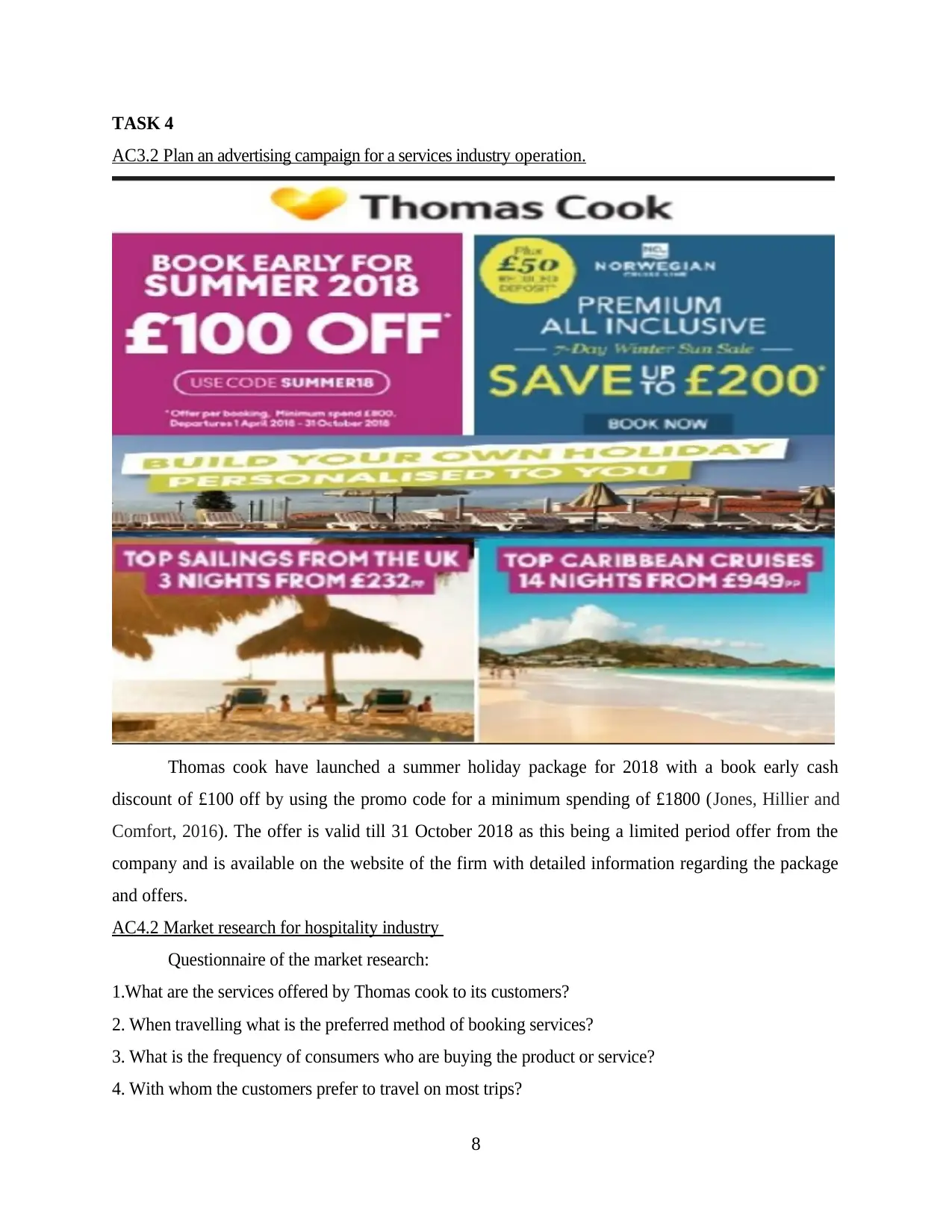
TASK 4
AC3.2 Plan an advertising campaign for a services industry operation.
Thomas cook have launched a summer holiday package for 2018 with a book early cash
discount of £100 off by using the promo code for a minimum spending of £1800 (Jones, Hillier and
Comfort, 2016). The offer is valid till 31 October 2018 as this being a limited period offer from the
company and is available on the website of the firm with detailed information regarding the package
and offers.
AC4.2 Market research for hospitality industry
Questionnaire of the market research:
1.What are the services offered by Thomas cook to its customers?
2. When travelling what is the preferred method of booking services?
3. What is the frequency of consumers who are buying the product or service?
4. With whom the customers prefer to travel on most trips?
8
AC3.2 Plan an advertising campaign for a services industry operation.
Thomas cook have launched a summer holiday package for 2018 with a book early cash
discount of £100 off by using the promo code for a minimum spending of £1800 (Jones, Hillier and
Comfort, 2016). The offer is valid till 31 October 2018 as this being a limited period offer from the
company and is available on the website of the firm with detailed information regarding the package
and offers.
AC4.2 Market research for hospitality industry
Questionnaire of the market research:
1.What are the services offered by Thomas cook to its customers?
2. When travelling what is the preferred method of booking services?
3. What is the frequency of consumers who are buying the product or service?
4. With whom the customers prefer to travel on most trips?
8
Paraphrase This Document
Need a fresh take? Get an instant paraphrase of this document with our AI Paraphraser
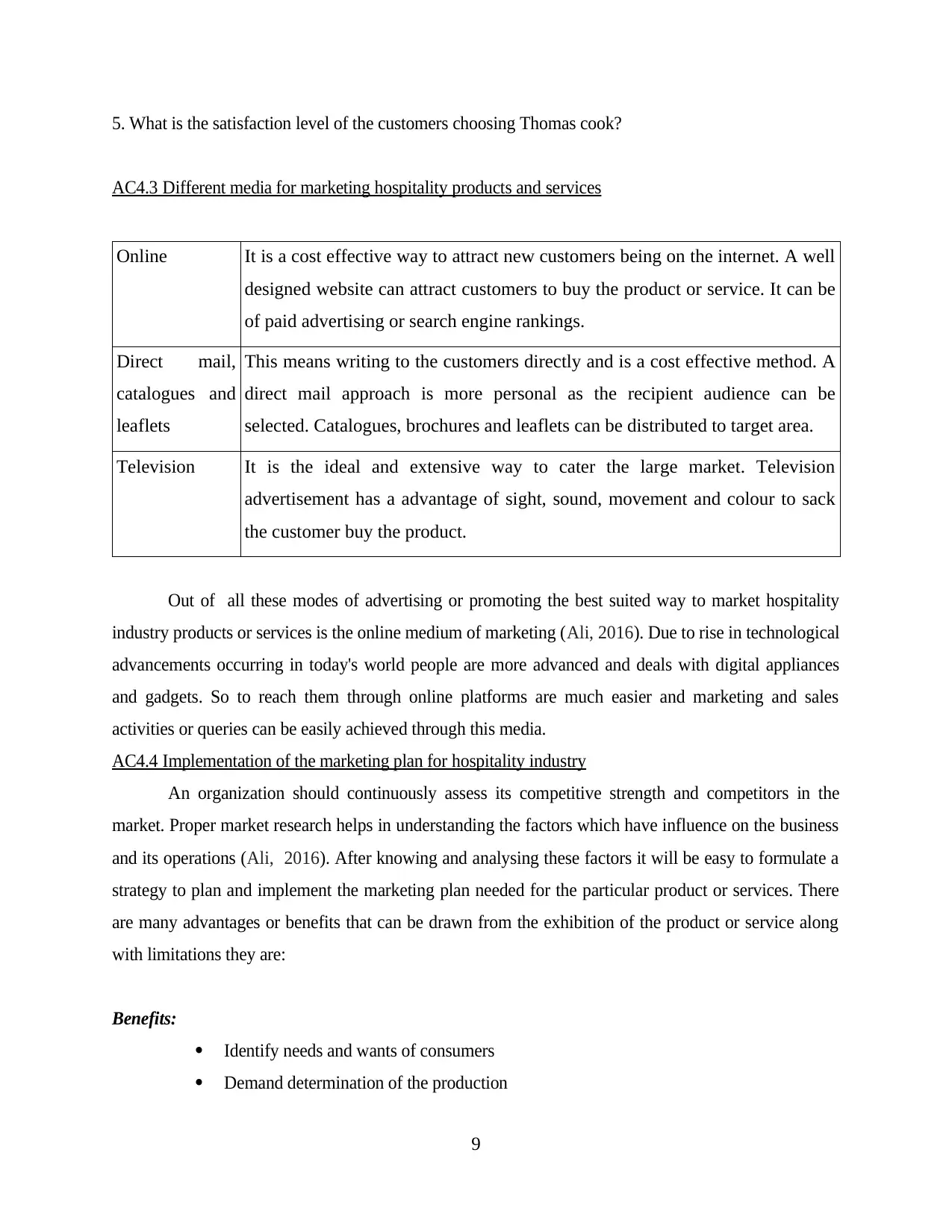
5. What is the satisfaction level of the customers choosing Thomas cook?
AC4.3 Different media for marketing hospitality products and services
Online It is a cost effective way to attract new customers being on the internet. A well
designed website can attract customers to buy the product or service. It can be
of paid advertising or search engine rankings.
Direct mail,
catalogues and
leaflets
This means writing to the customers directly and is a cost effective method. A
direct mail approach is more personal as the recipient audience can be
selected. Catalogues, brochures and leaflets can be distributed to target area.
Television It is the ideal and extensive way to cater the large market. Television
advertisement has a advantage of sight, sound, movement and colour to sack
the customer buy the product.
Out of all these modes of advertising or promoting the best suited way to market hospitality
industry products or services is the online medium of marketing (Ali, 2016). Due to rise in technological
advancements occurring in today's world people are more advanced and deals with digital appliances
and gadgets. So to reach them through online platforms are much easier and marketing and sales
activities or queries can be easily achieved through this media.
AC4.4 Implementation of the marketing plan for hospitality industry
An organization should continuously assess its competitive strength and competitors in the
market. Proper market research helps in understanding the factors which have influence on the business
and its operations (Ali, 2016). After knowing and analysing these factors it will be easy to formulate a
strategy to plan and implement the marketing plan needed for the particular product or services. There
are many advantages or benefits that can be drawn from the exhibition of the product or service along
with limitations they are:
Benefits:
Identify needs and wants of consumers
Demand determination of the production
9
AC4.3 Different media for marketing hospitality products and services
Online It is a cost effective way to attract new customers being on the internet. A well
designed website can attract customers to buy the product or service. It can be
of paid advertising or search engine rankings.
Direct mail,
catalogues and
leaflets
This means writing to the customers directly and is a cost effective method. A
direct mail approach is more personal as the recipient audience can be
selected. Catalogues, brochures and leaflets can be distributed to target area.
Television It is the ideal and extensive way to cater the large market. Television
advertisement has a advantage of sight, sound, movement and colour to sack
the customer buy the product.
Out of all these modes of advertising or promoting the best suited way to market hospitality
industry products or services is the online medium of marketing (Ali, 2016). Due to rise in technological
advancements occurring in today's world people are more advanced and deals with digital appliances
and gadgets. So to reach them through online platforms are much easier and marketing and sales
activities or queries can be easily achieved through this media.
AC4.4 Implementation of the marketing plan for hospitality industry
An organization should continuously assess its competitive strength and competitors in the
market. Proper market research helps in understanding the factors which have influence on the business
and its operations (Ali, 2016). After knowing and analysing these factors it will be easy to formulate a
strategy to plan and implement the marketing plan needed for the particular product or services. There
are many advantages or benefits that can be drawn from the exhibition of the product or service along
with limitations they are:
Benefits:
Identify needs and wants of consumers
Demand determination of the production
9
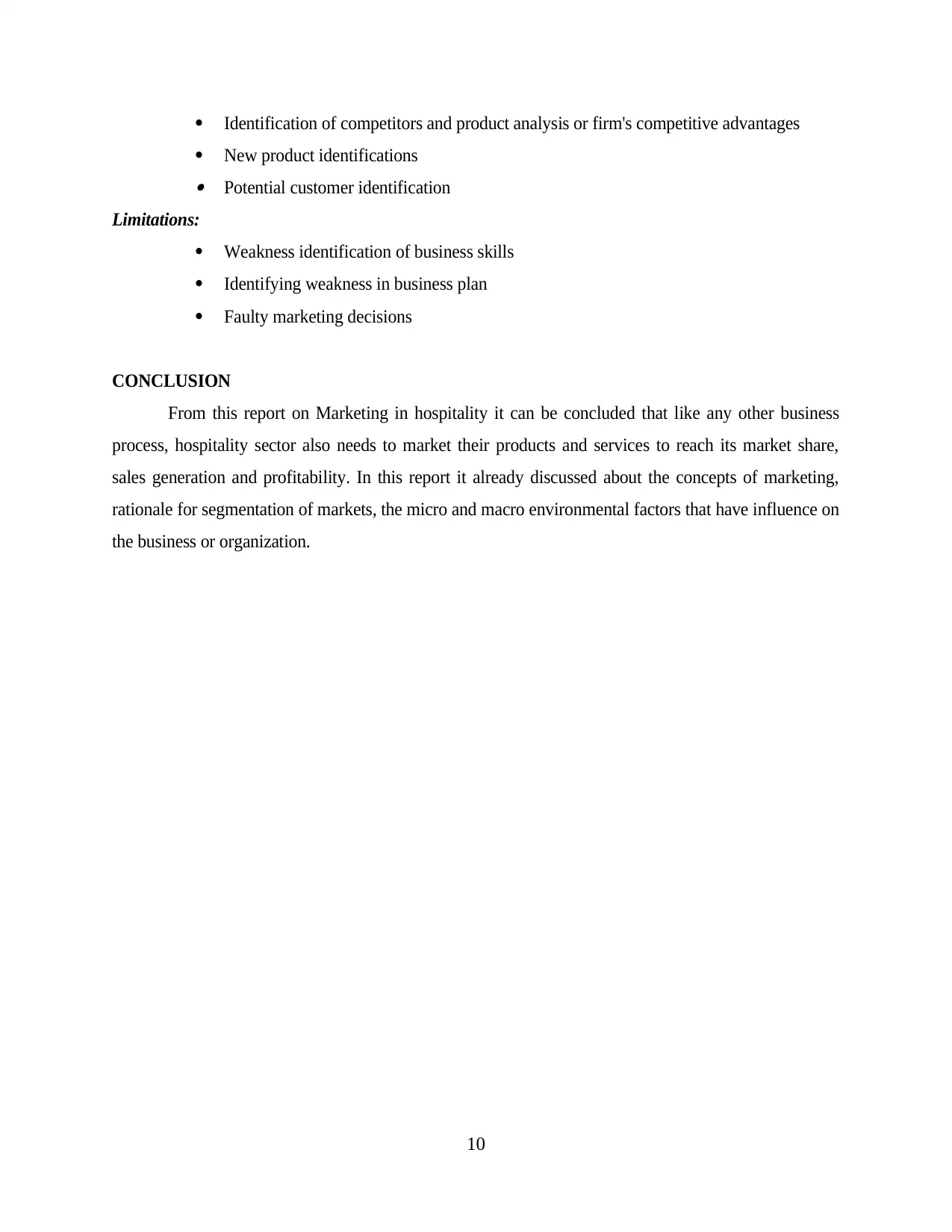
Identification of competitors and product analysis or firm's competitive advantages
New product identifications
Potential customer identification
Limitations:
Weakness identification of business skills
Identifying weakness in business plan
Faulty marketing decisions
CONCLUSION
From this report on Marketing in hospitality it can be concluded that like any other business
process, hospitality sector also needs to market their products and services to reach its market share,
sales generation and profitability. In this report it already discussed about the concepts of marketing,
rationale for segmentation of markets, the micro and macro environmental factors that have influence on
the business or organization.
10
New product identifications
Potential customer identification
Limitations:
Weakness identification of business skills
Identifying weakness in business plan
Faulty marketing decisions
CONCLUSION
From this report on Marketing in hospitality it can be concluded that like any other business
process, hospitality sector also needs to market their products and services to reach its market share,
sales generation and profitability. In this report it already discussed about the concepts of marketing,
rationale for segmentation of markets, the micro and macro environmental factors that have influence on
the business or organization.
10
⊘ This is a preview!⊘
Do you want full access?
Subscribe today to unlock all pages.

Trusted by 1+ million students worldwide
1 out of 14
Related Documents
Your All-in-One AI-Powered Toolkit for Academic Success.
+13062052269
info@desklib.com
Available 24*7 on WhatsApp / Email
![[object Object]](/_next/static/media/star-bottom.7253800d.svg)
Unlock your academic potential
Copyright © 2020–2025 A2Z Services. All Rights Reserved. Developed and managed by ZUCOL.





